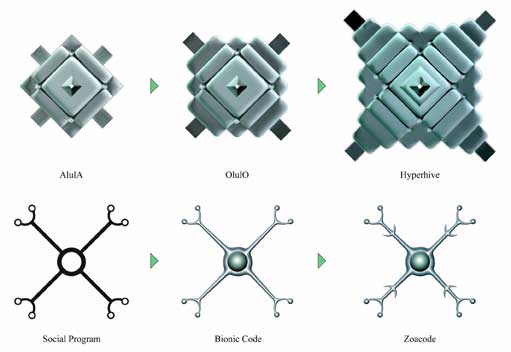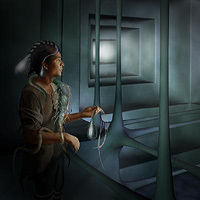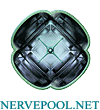
THE HYPERHIVE OF THE NERVEPOOL
CONVULSIVE EVOLUTION
While retaining a kernel of its original structure, The Nervepool's codes and architectural structures evolved in both form and nomenclature. Technological references gave way to biological metaphors and forms.
The Hyperhive first appeared as a handheld model in 1993 and by 1995 that model lead to a large installation which took over half my studio. That structure, measuring 3.5 meters high, was documented and explored in wave after wave of new media throughout much of the 1990s.The structure had multiple purposes. It acted as an icon for social connection, an actual space for dialogue, and a stable memetic reference point for media experiments during a period of rapid digital change. The structure appeared in live internet video and interactive VRML animations. It was invoked during experimental online dialogues with my students, and was the site for actual dinners, parties and media rituals. I also spent a considerable amount of time shooting fiction and non-fiction video in the space.
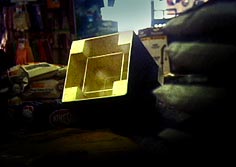 |
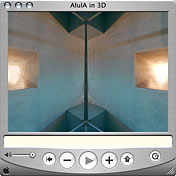 |
|
LEFT: An early model of the Hyperhive in an exhibit at Crest Hardware Store, Brooklyn (organized by Gene Pool).
MIDDLE: Early Quicktime VR. RIGHT: GIF animation for an early website.
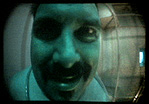 |
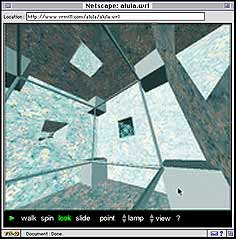 |
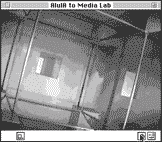
|
LEFT: Actor, Frank Senger in the AlulA stage of the Hyperhive. MIDDLE: VRML study. RIGHT: A still from a live internet video broadcast to a site at MIT's List Visual Arts Center (for an event called "Port," co-organized by GH Hovagimyan, Remo Campopiano, Robbin Murphy and myself).
Invited to set up a digital arts program at the University of Iowa in 1998, I had to abandon the physical Hyperhive, but continued developing the structure virtually using 3D animation software. In this new form the number of poles and terraces increased and curvilinear qualities began to emerge. At no point did I deem one media manifestation more complete or real than the other. The Hyperhive is an amalgamation of all its manifestations. I must confess, however, to a sense of animal-like maturing taking place in both the form and the attitude of the structure. It was as if my experiment in sustained architectural evolution replayed the trajectory from Romanesque simplicity to feral Gothic indulgence. Needless to say, I have been acutely aware of a need to avoid drifting towards nebulous Baroque complexity. Lively intensity of form was my goal. To mutate a Bauhaus term, form follows full furry function.
.
.
Studies of the Hyperhive in Lightwave 3D which began while teaching at the University of Iowa. A fictional world began to take form in reference to the Hyperhive resulting in costume studies, videos with live actors and a 180-page screenplay. Simultaneously a more utilitarian use of the Hyperhive has been in development involving dialogues with the presence of fish, plants and animals.
FROM MACHINE TO ORGANISMThe Hyperhive's evolution paralleled my own rather convulsive abandonment of "the machine" or "media system" as prime creative metaphor to that of "the organism." I now consider myself a "media breeder." I cultivate cultural phenomena rather than manufacture it. Memetic issues permeate my work, although as a participant in the evolution of culture I am interested in a subjective form of memetics and, for that matter, a subjective form of ecology.
All of this leads, among other things, to co-nurturing of living presence in the world. It's quite a personal endeavour, really, and I've had many odd conversations with "art world" devotees when I try to explain that my work has moved out of the "art" domain into a kind of cultural cultivation or gardening realm. Existentialism, with its emphasis on individual "truth" and responsibility, provides a starting point for such an approach, although the definition of the individual needs to be radically expanded. We do not function in isolation, but are quite part and parcel of wider ecosystems. Without an objective perch to map out the world, we collaborate with a very strange, psycho-social-informational environment. Thought, identity and our very livelihoods emerge out of this collaboration. (See Wigglism).
COLLECTIVE ORGANISMSAfter exploring information-sharing rituals for half a dozen years in Boston and Brooklyn, I had come to realize that culture, along with its evolving webs of communication, was emphatically not a refined art object. I began to see culture as an ongoing struggle to pull this phosphorescent swirl of a universe into collective focus. I began to see culture as an evolving collective organism of sorts, a hive of synchronized nerves, a "Nervepool." Ritual life, the superstructure of culture, provides a temporary sense of reality and a sense of grace within that. At its best, culture might create a context in which the thunderous mystery of the world shudders into view (as felt mystery as opposed to cogitated illusion). That's a tall order, and one which one should never assume mastery over, short of inviting a good stiff rock, or martini, in the face.
Culture as a collective practice, not any particular gizmo or art object, is the ultimate virtual reality system. With this in mind, I might hazard to describe the Hyperhive as a kind of cultural operating system. The physical structure catalysed and anchored a wide array of media forms, gatherings and dialogues. Even as the virtual structures evolved beyond the initial architecture, that first boxy cube-within-a-cube was still there as a kind of conceptual kernel or source code.
As I was in the habit of charting my former media rituals and networks in two dimensional form, transmuting them into a kind of social coding, I also couldn't help but regard this architectural entity as a three dimensional diagram. I have since come to regard all of architecture as both map and mechanism for bodily information-processing. In the case of the Hyperhive, the diagram zeros in on a single node within a network, re-casting that node as a potential hive of gestural, tactile and vocal communication – a hive within a hive. Hence Hyperhive.
|
|---|
__________________
© 2006 Ebon Fisher
